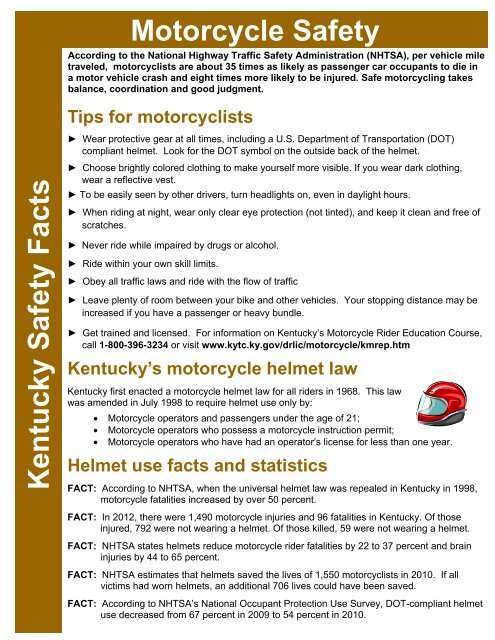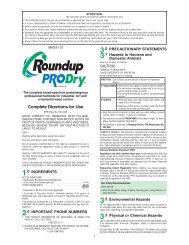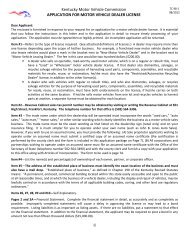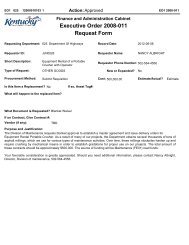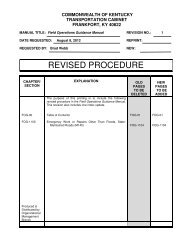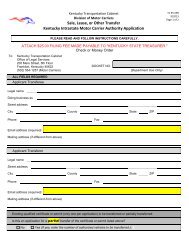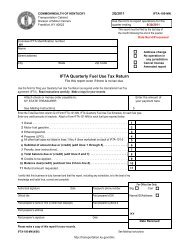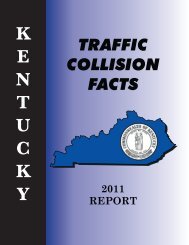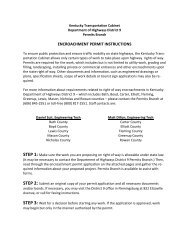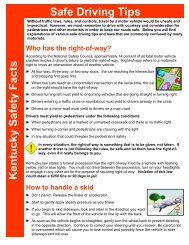Motorcycle Safety Kentucky Safety Facts - Kentucky Transportation ...
Motorcycle Safety Kentucky Safety Facts - Kentucky Transportation ...
Motorcycle Safety Kentucky Safety Facts - Kentucky Transportation ...
You also want an ePaper? Increase the reach of your titles
YUMPU automatically turns print PDFs into web optimized ePapers that Google loves.
<strong>Motorcycle</strong> <strong>Safety</strong>According to the National Highway Traffic <strong>Safety</strong> Administration (NHTSA), per vehicle miletraveled, motorcyclists are about 35 times as likely as passenger car occupants to die ina motor vehicle crash and eight times more likely to be injured. Safe motorcycling takesbalance, coordination and good judgment.<strong>Kentucky</strong> <strong>Safety</strong> <strong>Facts</strong>Tips for motorcyclists► Wear protective gear at all times, including a U.S. Department of <strong>Transportation</strong> (DOT)compliant helmet. Look for the DOT symbol on the outside back of the helmet.► Choose brightly colored clothing to make yourself more visible. If you wear dark clothing,wear a reflective vest.► To be easily seen by other drivers, turn headlights on, even in daylight hours.► When riding at night, wear only clear eye protection (not tinted), and keep it clean and free ofscratches.► Never ride while impaired by drugs or alcohol.► Ride within your own skill limits.► Obey all traffic laws and ride with the flow of traffic► Leave plenty of room between your bike and other vehicles. Your stopping distance may beincreased if you have a passenger or heavy bundle.► Get trained and licensed. For information on <strong>Kentucky</strong>’s <strong>Motorcycle</strong> Rider Education Course,call 1-800-396-3234 or visit www.kytc.ky.gov/drlic/motorcycle/kmrep.htm<strong>Kentucky</strong>’s motorcycle helmet law<strong>Kentucky</strong> first enacted a motorcycle helmet law for all riders in 1968. This lawwas amended in July 1998 to require helmet use only by: <strong>Motorcycle</strong> operators and passengers under the age of 21; <strong>Motorcycle</strong> operators who possess a motorcycle instruction permit; <strong>Motorcycle</strong> operators who have had an operator’s license for less than one year.Helmet use facts and statisticsFACT: According to NHTSA, when the universal helmet law was repealed in <strong>Kentucky</strong> in 1998,motorcycle fatalities increased by over 50 percent.FACT: In 2012, there were 1,490 motorcycle injuries and 96 fatalities in <strong>Kentucky</strong>. Of thoseinjured, 792 were not wearing a helmet. Of those killed, 59 were not wearing a helmet.FACT: NHTSA states helmets reduce motorcycle rider fatalities by 22 to 37 percent and braininjuries by 44 to 65 percent.FACT: NHTSA estimates that helmets saved the lives of 1,550 motorcyclists in 2010. If allvictims had worn helmets, an additional 706 lives could have been saved.FACT: According to NHTSA’s National Occupant Protection Use Survey, DOT-compliant helmetuse decreased from 67 percent in 2009 to 54 percent in 2010.
Share the road with motorcycles► <strong>Motorcycle</strong>s are vehicles with the same rights and privileges as any vehicle on theroadway.► Allow the motorcyclist a full lane width. The motorcycle needs the room tomaneuver safely.► Approximately half of all motorcycle crashes involve another motor vehicle. Nearly40 percent were caused by the other vehicle turning left in front of the motorcyclist.► <strong>Motorcycle</strong>s are small and may be difficult to see. They have a smaller profile thanmany vehicles, which can make it more difficult to judge the speed and distance of an approaching motorcyclist.► Always signal your intentions before changing lanes or merging with traffic. This allows the motorcyclistto anticipate traffic flow and find a safe lane position.► Remember that motorcyclists are often hidden in a blind spot or missed in a quick look due to theirsmaller size. Always check mirrors and blind spots before entering or leaving a lane of traffic and atintersections.► Don’t be fooled by a flashing turn signal on a motorcycle—their turn signals usually are not selfcancelling.Wait to be sure the motorcycle is going to turn before you proceed.► Road conditions that are minor annoyances to you pose major hazards to motorcyclists. Motorcyclistsmay change their speed or adjust their position within a lane suddenly in reaction to road and trafficconditions such as potholes, gravel, wet or slippery surfaces, pavement seams, railroad crossings, andgrooved pavement.► Allow a greater following distance, three or four seconds, when following a motorcycle so themotorcyclist has enough time to maneuver or stop in an emergency. In dry conditions, motorcycles canstop more quickly than cars.www.msf-usa.org<strong>Kentucky</strong> <strong>Motorcycle</strong> Rider Education ProgramTraffic <strong>Safety</strong> InstituteEastern <strong>Kentucky</strong> University521 Lancaster AvenueRichmond, KY 40475-31021-800-396-3234http://drlic.kytc.ky.gov/motorcycle/kmrep.htmFor additional information: <strong>Kentucky</strong> Governor’s Commission on <strong>Motorcycle</strong> <strong>Safety</strong> and Education:http://kentuckymotorcycleeducationandsafety.ky.gov/ <strong>Kentucky</strong> <strong>Transportation</strong> Cabinet, Division of Driver Licensing: http://drlic.kytc.ky.gov/ National Highway Traffic <strong>Safety</strong> Administration: www.nhtsa.dot.gov<strong>Kentucky</strong> <strong>Transportation</strong> CabinetOffice of Highway <strong>Safety</strong>http://highwaysafety.ky.gov502-564-1438 or 1-888-374-8768


